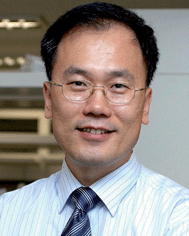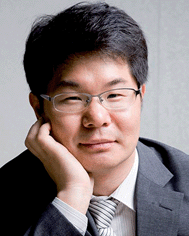10th Anniversary Issue: Korea
Je-Kyun
Park
a and
Kahp-Yang
Suh
b
aDepartment of Bio and Brain Engineering, Korea Advanced Institute of Science and Technology (KAIST), Korea
bSchool of Mechanical and Aerospace Engineering, Seoul National University (SNU), Korea
 Je-Kyun Park | Je-Kyun Park is a Professor of Bio and Brain Engineering at the Korea Advanced Institute of Science and Technology (KAIST). He obtained his PhD degree in biotechnology from the KAIST in 1992. Prior to joining KAIST, he worked as a Postdoctoral Fellow in the Department of Biomedical Engineering at the Johns Hopkins University School of Medicine in the USA (1996–1997) and as Chief Research Engineer at the LG Electronics Institute of Technology in Korea (1992–2002). His expertise spans interdisciplinary fields of biotechnology, bioelectronics and bioMEMS. He has been an editorial board member of several international journals, including Biosensors and Bioelectronics, and BioChip Journal. In 2010, he became an editorial board member for Lab on a Chip, and the Chair of the BioMEMS and Lab on a Chip Committee at The Korean BioChip Society. His research focuses on microfluidic lab on a chip platforms for biological sample processing and detection, including optoelectrofluidics, hydrophoretic separation, magnetophoretic assays, and cell-based assays. |
 Kahp-Yang Suh | Prof. Kahp-Yang Suh was born in Seoul, South Korea in 1972. After obtaining his PhD degree from the School of Chemical and Biological Engineering at Seoul National University (SNU) in 2002, he moved to MIT for postdoctoral research with Prof. Robert Langer, working on the merger of micro/nanotechnologies with tissue engineering and lab on a chip. He began his independent career in 2004 as assistant professor in the Mechanical and Aerospace Engineering at SNU and was promoted to associate professor in 2008. He wrote more than 140 papers in peer-reviewed journals and holds 10 domestic or international patents. He won a number of awards, including TR100 Young Innovator Award (2004) by MIT Technology Review, Young Professor Award by College of Engineering of SNU (2007), and Young Researcher Award by the Korean BioChip Society (2008). More recently, he won the Presidential Young Scientist Award (2010) from the Korean Government. He served as an editorial board member of Lab on a Chip for three years (2007–2009). His group is working on various engineering approaches to control cellular microenvironments for guided cell adhesion, migration and differentiation, and organ chips such as kidney and heart chips. |
Shooting for another success like the microelectronics industry
This special issue highlights recent developments and research in the lab-on-a-chip (LOC) community in Korea. Korea's miniaturization history dates back to the early 11th century when the first movable metal characters were invented to print out the Buddhist scriptures.1 After 200 years, they were re-invented and spread throughout Europe by the German, Johannes Gutenberg. Korea has shown incredible talent and passion for miniaturization, which has borne fruit in the microelectronics and display industries (e.g., Samsung and LG Electronics). In particular, Korea has experienced remarkable progress in nanotechnology in terms of its research capability and industrial impact following the establishment of its own National Nanotechnology Initiative Program in 2001. According to the statistics released by the Korean government, the number of nanotechnology-related companies has almost tripled from 78 to 214 in the period between 2001 and 2005. Currently, about 350 companies (more than half are venture capital-backed companies) are classified as nanotechnology-related businesses.Korea's LOC history, however, has been relatively short with only a handful of groups working in the field during the 1990s. The National G7 MEMS project (1995–2002) was initiated with general consensus from all governmental funding agencies, with the aim of commercializing MEMS technology. In spite of significant efforts, commercialization was confronted with many technical challenges, meanwhile, huge manpower resources, after graduation and training, have gradually moved to BioMEMS or LOC fields thanks to the growing interest in biotechnology and medical areas. For example, from the early 2000s, MEMS-based DNA or protein chip technologies have been developed by an industrial research consortium, including Samsung, LG Electronics, Macrogen, etc., for the Next Generation New Technology Development Project funded by the Korean government. In 2003, the Intelligent Microsystem Center, which is one of the 21st Century Frontier Research and Development (R&D) Programs (∼9 M $/year, 10-year National Project), changed their research direction to develop two primary goals: multi-function endoscopic microcapsules and micro medical diagnostic systems. These programs have initiated the widespread recognition and adoption of LOC techniques in academia as well as in industry and spun off a number of venture capital-backed companies including the most successful one, NanoEnTek. Recently, the first prototype of a capsule endoscope called “IMC MiRO” has been commercialized in two local hospitals in Korea and several point-of-care devices (e.g., cell counter, electroporation, and cantilever-based biosensors) are available or ready to go to market. Very recently, Samsung has announced a new healthcare and medical business, introducing a clinical blood analyzer (IVD-A10A) based on a compact disc-type microfluidic device.
During the last decade, Korea, even as a late-starter, has shown unprecedented progress in LOC fields. The number of scientific papers related to microfluidics or LOC has increased from 157 to 941 in the last five years (by using a simple keyword search “Microfluidic* AND Korea” in Scopus), which, more remarkably, has been driven and contributed to by many young scientists and engineers under the age of 50. As was seen at the MicroTAS 2009 Conference on Jeju Island, the Korean LOC community is rapidly growing with contributions from diverse areas of research, including biology, chemistry, physics, mechanical engineering, electrical engineering, chemical engineering and bioengineering. The Korean BioChip Society (since 2006) as well as the Korean MEMS Conference (since 1999) has played pivotal roles as major drivers for rapid growth. Another boost can be found in the Nano/Bio Science and Technology Programs through the National Research Foundation of Korea funded by the Ministry of Education, Science and Technology (MEST). In 2006, the Korean government formulated “Bio-Vision 2016” to acquire competitive platform technologies and expand industrial infrastructure over the next 10 years (2007–2016). Currently, the R&D expenditure on the bioconvergence area in Korea accounts for 9% of the total investment in the government sector.
Celebrating the 10th anniversary of Lab on a Chip, this special issue showcases some of the ongoing progress and achievements in Korea from various disciplines ranging from basic material and device fabrication to commercialized devices. Je-Kyun Park gives a comprehensive review of optoelectrofluidics for chemistry and biology (DOI: 10.1039/C0LC00117A). Dong-Yol Yang introduces a new concept for a crossing manifold micro-mixer (DOI: 10.1039/C005325M). Jeong-Gun Lee and Hyo-Il Jung report a multistage-multiorifice flow fractionation method for improving recovery yield of size-based particle separation (DOI: 10.1039/C0LC00109K). Dong-Pyo Kim demonstrates a 3D-ordered macroporous structure, embedded within a microchannel, used for catalytic microchemical applications (DOI: 10.1039/C0LC00108B). Sunghoon Kwon reports magnetic manipulation of 3D hydrogel cell microcarriers (DOI: 10.1039/C0LC00369G). Seung-Man Yang demonstrates the microfluidic fabrication of surface-enhanced Raman scattering-active microspheres with hierarchical surface nanopatterns for molecular detection (DOI: 10.1039/C0LC00125B). Young-Ho Cho presents a multicellular spheroid chip that is capable of forming and extracting three-dimensional spheroids using removable cell trapping barriers (DOI: 10.1039/C0LC00134A).
Sang-Hyun Park and Kahp-Yang Suh describe a microfluidic platform for measuring time-course single-cell responses on a large scale (DOI: 10.1039/C0LC00114G). Joon Myong Song reports a high-content quantitative multicolor single cell imaging tool for automatic screening of drug-induced cardiotoxicity (DOI: 10.1039/C0LC00110D). Soyoun Kim and Seunghun Hong report an aptamer sandwich-based carbon nanotube sensor strategy for small molecule detection (DOI: 10.1039/C0LC00259C). Sang Kyung Kim and Tae Song Kim demonstrate DNA analysis using piezoelectric microcantilevers to extract structural information on oligonucleotides (DOI: 10.1039/C0LC00122H). Yoon-Kyoung Cho describes an integrated lab-on-a-disc for immunoassay from whole blood (DOI: 10.1039/C0LC00205D). Dae-Sik Lee presents a novel mobile healthcare platform, combining a pocket-sized colorimetric reader for urinalysis (DOI: 10.1039/C0LC00209G).
Judging from history and the many recent accomplishments, we believe that Korea has a tremendous amount of growth potential for developing target based R&D to create a niche market in LOC fields. The featured 13 papers will help to highlight recent R&D activities in Korea—we hope the readers will find them useful in their microfluidic studies and serve to strengthen international collaboration.
Reference
- R. Goepper and J. Lee-Kalisch, “Korea: Die alten Königreiche” Kulturstiftung Ruhr Essen (Katalog) Museum Rietberg, Gablerstrasse 15, CH-8002 Zurich, Switzerland, 2000, p. 258 Search PubMed.
| This journal is © The Royal Society of Chemistry 2011 |
